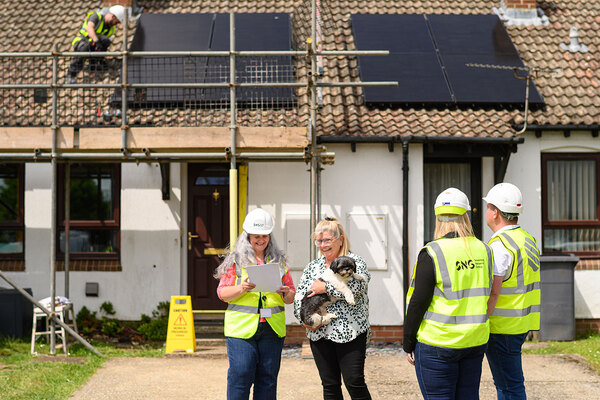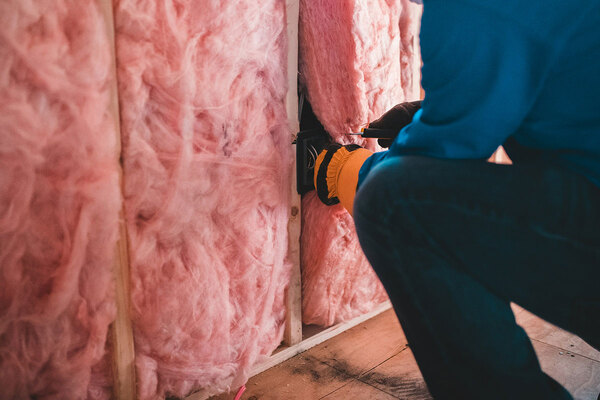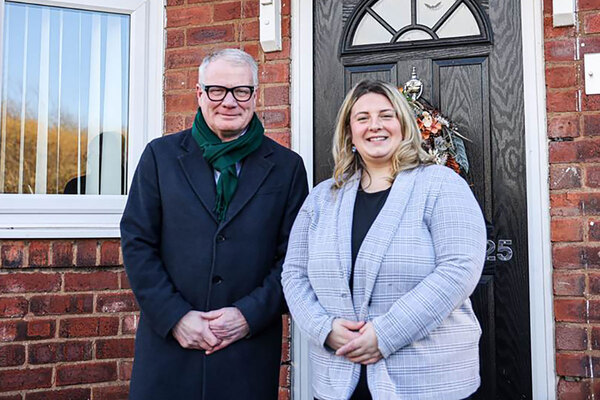Can fuel poverty and the climate crisis be addressed at the same time?
An Inside Housing workshop, in association with low-carbon energy solutions expert Equans, explores how landlords can decarbonise stock and help residents manage their fuel bills. Photography by Guzelian

In association with:
![]()
For much of the recent past, the number of people living in fuel poverty in the UK has either been stable or fallen slightly, according to government statistics – but that trend has now reversed sharply. Following the increase in the energy price cap in April, energy regulator Ofgem estimates there are 6.5 million UK households living in fuel poverty – and says that the further increase in the price cap expected in October this year could push that figure as high as 12 million.
Decarbonising the country’s housing stock, meanwhile, should ease this pressure in the long term. Better insulation, for example, should cut heating bills. But it is not so simple as to say every measure that reduces carbon emissions also cuts energy bills.
“Around decarbonisation of stock, the simplest thing to do is to get rid of gas and put some sort of renewable heating in, and that’s generally electricity driven,” says Stephen Batty, head of sustainability at Equans. “But if we just did that, ultimately, it’ll increase residents’ bills.”
Inside Housing brought together a panel of experts for a discussion, sponsored by Equans, about how social landlords can continue to decarbonise their stock, while helping residents to manage their fuel bills – all while minimising disruption to people’s daily lives.
The discussion began with presentations from two experts: Lizzy Westmacott, assistant director and joint head of sustainability at ECD Architects, and Samantha Granger, head of environmental sustainability at Thirteen. “We’ve been asked to talk about fuel poverty vs climate change, but I don’t see those two things as in opposition to each other,” Ms Westmacott says. “Hopefully the work we’re doing is taking them both in a positive direction.”
The balance that must be struck is between reducing carbon emissions and lowering bills, she adds. “They’re not in opposition, they’re working together. But until the relative cost of electricity compared to gas comes down, that’s stopping us fully going towards the zero-carbon country and homes that we need to be living in.”
But the energy landscape is shifting fast, and some experts believe the price of gas is now – or will soon be – high enough to reverse this equation. Analysis by thinktank the Regulatory Assistance Project suggests that if gas prices rise as expected, heat pumps could be up to 27% cheaper to run than gas boilers.
“We’ve been asked to talk about fuel poverty vs climate change, but I don’t see those two things as in opposition to each other”
There is a short-term challenge – tackling the fuel poverty crisis – and the long-term challenge presented by the climate crisis. The two should be complementary, as Ms Westmacott points out, but social landlords still have to answer the fundamental question: what is the most impactful way to start addressing both today?
The government wants to ban all installations of new gas boilers by 2035. Heat pumps have been touted as their replacement. In trials, ECD found replacing boilers with air source heat pumps cut carbon emissions in half.
“Not only is the home using less energy, but the way that energy is delivered is less fossil fuel-intensive,” says Ms Westmacott. “But bills don’t come down a great deal further. So we’d be doing a lot of work and residents’ lives would be really disrupted [for little financial benefit].”
“A smattering of people were interested in [decarbonisation], but in general, it was affordability, it was improving the quality of their home”
Ms Granger says: “We’ve got 35,000 homes that we need to retrofit, and they’ve all got customers living in them. We need to take all of our customers on that journey with us, and ensure that what we’re doing is right for them as well as for our homes, because you cannot separate the two. If customers are not happy, they’re not going to look after the asset.”
The residents that Jack Wilkinson-Dix, policy officer at the Energy Saving Trust, has spoken to are more interested in how works will improve their day-to-day lives than long-term decarbonisation goals.
“A smattering of people were interested in [decarbonisation], but in general, it was affordability, it was improving the quality of their home,” he says. “We expected that focus on affordability because prices are as high as they are.”
Tom Boome, head of technical, innovation and climate at 6,000-home housing association ClwydAlyn, says that his organisation’s aims are aligned with its residents.
“We really look to make an impact in people’s lives, rather than just doing it for decarbonisation… it’s about energy efficiency, [lower] bills,” he says.
Part of ClwydAlyn’s approach has been to make sure residents are kept informed and up to date, he adds. “It’s about understanding, education – it’s demystifying the works for residents.”
One theme that cropped up repeatedly was about where to make the initial investment in energy-efficiency retrofit. Should landlords focus on improving buildings’ fabric first, or is installing technology a more effective opener? Opinions were divided.
“Based on the challenges of spreading investment across a portfolio of 54,000 properties, I’m not sure that right now fabric-first is the right strategy for us,” says Nahim Ruhi-Khan, head of strategy and investment at Leeds City Council. “We have found that the benefits of renewables and low-carbon energy sources make a far bigger difference to tenants, and to their homes’ [Energy Performance Certificate] reports, than investing in fabric-first approaches. That has been driven by an increase in the cost of external wall insulation.”
Mr Boome takes the opposite view. “I think we’re pretty much all in agreement that the fabric needs to come first,” he says. “But when it comes to cost, we’re under no illusions that it’s a cheap thing to do, especially with some of the worst-performing homes.”
But better thermal performance has multiple benefits, he adds, and we should consider those, too: lifting residents out of fuel poverty improves their health and well-being, and makes a dent in NHS admissions.
Ultimately, all retrofit measures will make a difference to fuel poverty in the short term and decarbonisation in the long term. What is crucial is that those measures are taken. If the average resident continues to spend the same amount on their energy bills once prices go up again, Mr Batty points out, the average temperature in their property will have to come down.
“It’s going to drop from 19°C to around 16°C,” he says. “And at 15°C, 16°C, that’s when we start getting damp and mould and condensation, which would also have a knock-on effect on maintenance and disrepair costs.”
Experts can debate the pros and cons of fabric-first and technology-first approaches, but it is inaction that will incur the most significant costs.
Sign up for our asset management newsletter
Already have an account? Click here to manage your newsletters














